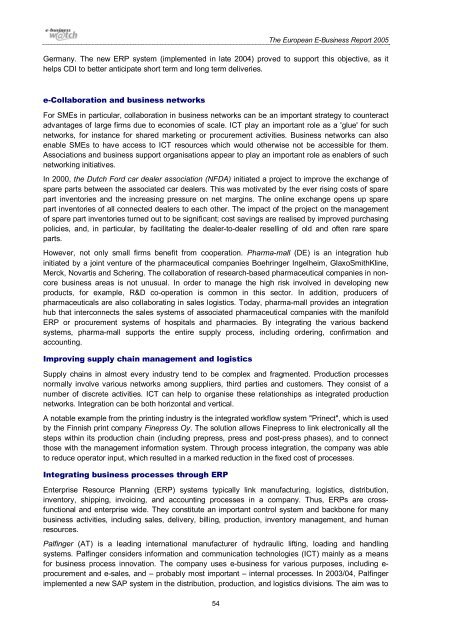The European e-Business Report The European e ... - empirica
The European e-Business Report The European e ... - empirica
The European e-Business Report The European e ... - empirica
Create successful ePaper yourself
Turn your PDF publications into a flip-book with our unique Google optimized e-Paper software.
<strong>The</strong> <strong>European</strong> E-<strong>Business</strong> <strong>Report</strong> 2005<br />
Germany. <strong>The</strong> new ERP system (implemented in late 2004) proved to support this objective, as it<br />
helps CDI to better anticipate short term and long term deliveries.<br />
e-Collaboration and business networks<br />
For SMEs in particular, collaboration in business networks can be an important strategy to counteract<br />
advantages of large firms due to economies of scale. ICT play an important role as a 'glue' for such<br />
networks, for instance for shared marketing or procurement activities. <strong>Business</strong> networks can also<br />
enable SMEs to have access to ICT resources which would otherwise not be accessible for them.<br />
Associations and business support organisations appear to play an important role as enablers of such<br />
networking initiatives.<br />
In 2000, the Dutch Ford car dealer association (NFDA) initiated a project to improve the exchange of<br />
spare parts between the associated car dealers. This was motivated by the ever rising costs of spare<br />
part inventories and the increasing pressure on net margins. <strong>The</strong> online exchange opens up spare<br />
part inventories of all connected dealers to each other. <strong>The</strong> impact of the project on the management<br />
of spare part inventories turned out to be significant; cost savings are realised by improved purchasing<br />
policies, and, in particular, by facilitating the dealer-to-dealer reselling of old and often rare spare<br />
parts.<br />
However, not only small firms benefit from cooperation. Pharma-mall (DE) is an integration hub<br />
initiated by a joint venture of the pharmaceutical companies Boehringer Ingelheim, GlaxoSmithKline,<br />
Merck, Novartis and Schering. <strong>The</strong> collaboration of research-based pharmaceutical companies in noncore<br />
business areas is not unusual. In order to manage the high risk involved in developing new<br />
products, for example, R&D co-operation is common in this sector. In addition, producers of<br />
pharmaceuticals are also collaborating in sales logistics. Today, pharma-mall provides an integration<br />
hub that interconnects the sales systems of associated pharmaceutical companies with the manifold<br />
ERP or procurement systems of hospitals and pharmacies. By integrating the various backend<br />
systems, pharma-mall supports the entire supply process, including ordering, confirmation and<br />
accounting.<br />
Improving supply chain management and logistics<br />
Supply chains in almost every industry tend to be complex and fragmented. Production processes<br />
normally involve various networks among suppliers, third parties and customers. <strong>The</strong>y consist of a<br />
number of discrete activities. ICT can help to organise these relationships as integrated production<br />
networks. Integration can be both horizontal and vertical.<br />
A notable example from the printing industry is the integrated workflow system "Prinect", which is used<br />
by the Finnish print company Finepress Oy. <strong>The</strong> solution allows Finepress to link electronically all the<br />
steps within its production chain (including prepress, press and post-press phases), and to connect<br />
those with the management information system. Through process integration, the company was able<br />
to reduce operator input, which resulted in a marked reduction in the fixed cost of processes.<br />
Integrating business processes through ERP<br />
Enterprise Resource Planning (ERP) systems typically link manufacturing, logistics, distribution,<br />
inventory, shipping, invoicing, and accounting processes in a company. Thus, ERPs are crossfunctional<br />
and enterprise wide. <strong>The</strong>y constitute an important control system and backbone for many<br />
business activities, including sales, delivery, billing, production, inventory management, and human<br />
resources.<br />
Palfinger (AT) is a leading international manufacturer of hydraulic lifting, loading and handling<br />
systems. Palfinger considers information and communication technologies (ICT) mainly as a means<br />
for business process innovation. <strong>The</strong> company uses e-business for various purposes, including e-<br />
procurement and e-sales, and – probably most important – internal processes. In 2003/04, Palfinger<br />
implemented a new SAP system in the distribution, production, and logistics divisions. <strong>The</strong> aim was to<br />
54

















